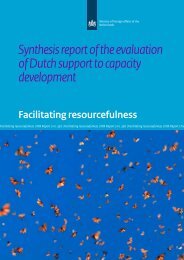Pro-Poor Value Chain Development - Capacity.org
Pro-Poor Value Chain Development - Capacity.org
Pro-Poor Value Chain Development - Capacity.org
Create successful ePaper yourself
Turn your PDF publications into a flip-book with our unique Google optimized e-Paper software.
52<br />
4. Exponential growth in information and communications technology has<br />
transformed the ability to take advantage of knowledge developed in other<br />
places or for other purposes;<br />
5. The knowledge structure of the agricultural sector in many countries is changing<br />
markedly;<br />
6. Agricultural development is increasingly taking place in a globalised setting.<br />
Figure 3.1: The traditional knowledge management model<br />
(adapted from Boekhoff et al, 1998)<br />
Strategic content<br />
of knowledge<br />
Purpose<br />
Why?<br />
Developement of knowledge<br />
and testing<br />
Determine necessary<br />
knowledge<br />
Inventory of existing<br />
knowledge<br />
Acquisition of<br />
knowledge<br />
Knowledge management:<br />
-Steering and structuring the knowledge chain process<br />
-Key issues: effectiveness, efficiency and flexibility<br />
-Using different tools<br />
Knowledge Applying of Evaluating<br />
documentation Upscaling of<br />
and transfer knowledge<br />
knowledge<br />
Can be one<br />
with developing<br />
knowledge<br />
An innovation system can be defined as: “…a network of <strong>org</strong>anizations, enterprises,<br />
and individuals focused on bringing new products, new processes, and new forms<br />
of <strong>org</strong>anization into economic use, together with the institutions and policies that<br />
affect their behaviour and performance. The innovation systems concept embraces<br />
not only the science suppliers but the totality and interaction of actors involved in<br />
innovation. It extends beyond the creation of knowledge to encompass the factors<br />
affecting demand for and use of knowledge in novel and useful ways” (The World<br />
Bank, 2006).<br />
<strong>Value</strong> chains are complex systems (Camps and Batterink et al, 2004) characterised<br />
by the presence of many actors and other interactive elements that influence the<br />
dynamics of the entire system. The number and variety of linkages between these<br />
different elements is so diverse that it is very difficult - some would argue impossible<br />
- to predict the outcome of any intervention. Right from the outset, therefore,<br />
BOAM adopted the concept of innovation systems as the <strong>org</strong>anising principle for its<br />
approach to facilitating knowledge development and learning in value chains. When<br />
applied to this complex multi-actor environment, a systems perspective enables<br />
practitioners to move away from top-down linear planning to interventions that are<br />
more interactive, learning oriented and adaptive.













